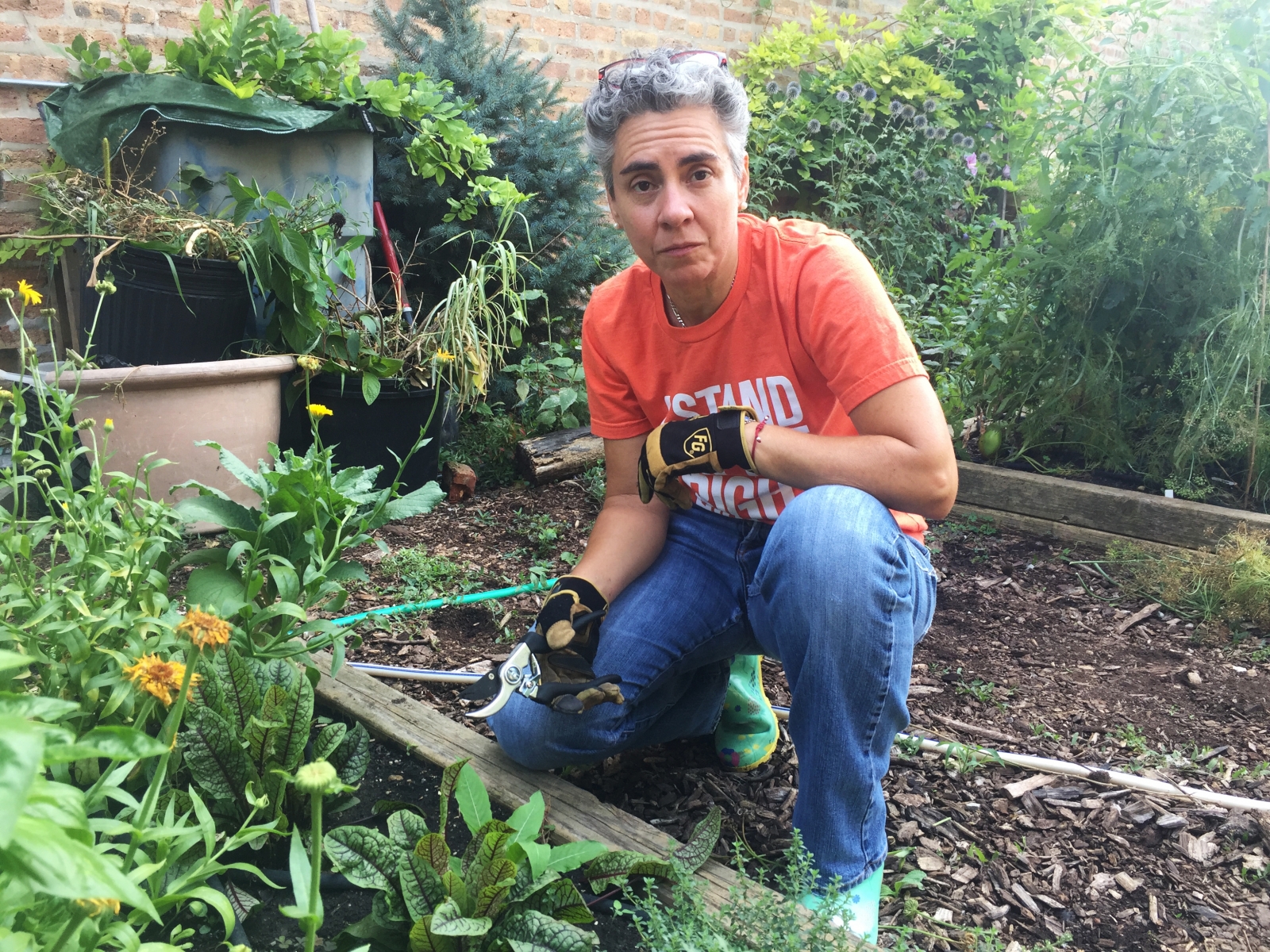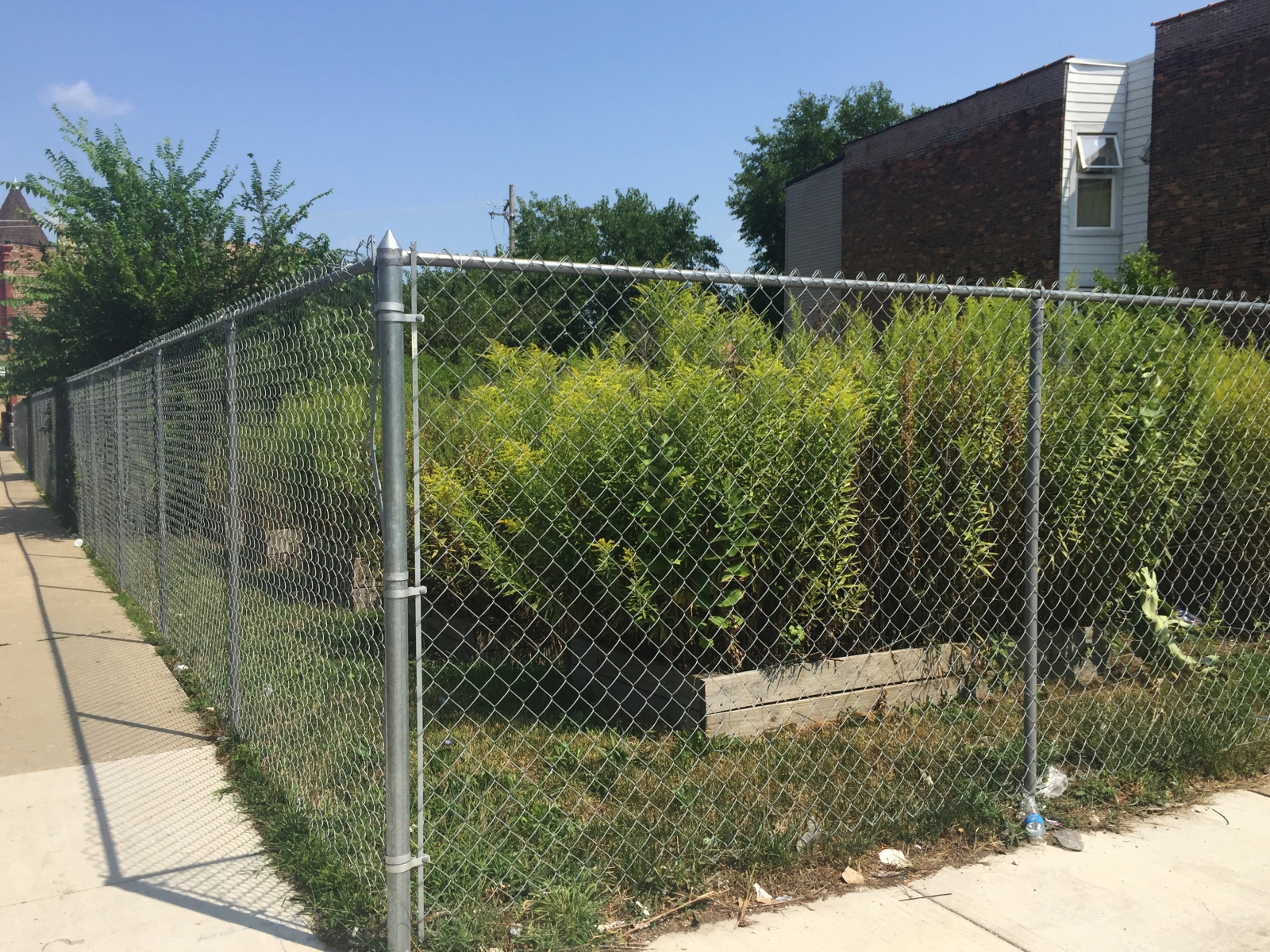Luerlis Gutierrez celebrated when she learned about a Chicago program meant to inspire neighbors to beautify their communities. The East Garfield Park resident had long bemoaned the empty lots in her neighborhood, and Large Lots — an ongoing initiative that allows nearby homeowners, block clubs, and developers across Chicago to buy empty, city-owned lots for $1 — sounded promising.
“We love the neighborhood, but what many people think is that this is a ghetto,” Gutierrez says. “I want to see this area clean.”
Little did she suspect that the program, in the end, would lead to the destruction of her neighborhood garden on West Fulton Street — an oasis of fruit and flowers marked with a hand-painted sign that reads, “Fulton Garden.” Five neighbors started planting at the then-vacant plot in 2010; under Gutierrez’s guidance as the expert green thumb, it expanded to the empty lot next door the following year.
But today, Fulton Garden is sliced in two. Gutierrez and two others still care for 2946 West Fulton Street; the former green space at 2948 West Fulton Street is cluttered with weeds, garbage, and other debris.
“That’s one of the things that really bothers me about the Large Lots program,” Gutierrez says. “It’s like they’re saying they’re going to invest, build something for the community. They’re not doing anything.”
In 2011, Gutierrez’s work caught the attention of Ald. Walter Burnett Jr. (27th). He wrote to community gardening program Greencorps Chicago, saying he supported a “property hold in acquiring” the garden so its caretakers could cultivate the land without threat of development.
Four years later, Burnett wrote another letter — this time to NeighborSpace, a nonprofit urban land trust — expressing his “full support” of Fulton Garden. He noted that he would appreciate NeighborSpace’s recognition of the garden, which would eventually lead to the city transferring its deed on the property to the land trust — the official process the city uses to protect community gardens.
But somewhere along the way, signals between community members and city officials shorted out. Eight days after Burnett wrote NeighborSpace, he joined city officials in selling Fulton Garden through Large Lots.

The Large Lots program launched in 2014, starting in Englewood. It then expanded across Chicago as a way to empower residents by allowing them to invest locally, decrease crime, and get vacant lots back on property tax rolls and off the municipal maintenance list. The city acquired many of these lots through tax delinquencies and demolition liens, the Tribune reported; most are clustered on the South and West sides.
When the next application round opens in early December, property owners can visit LargeLots.org to see if a vacant, city-owned lot — either on, or across from — their block is for sale. Department of Planning and Development officials vet applications, and aldermen vote to approve or deny the sales.
Public agencies and land banks in cities including Rochester, Kansas City, and New Orleans have all contacted Chicago about starting similar programs, according to Peter Strazzabosco, deputy commissioner of the Department of Planning and Development. It’s easy to see why Large Lots is an appealing model. Success stories tout the transformation of some 1,250 Chicago lots sold through this program into children’s parks, outdoor gathering spaces for seniors, and community gardens.
But in East Garfield Park, Large Lots quashed the growth of at least two gardens, leaving the lots vacant and in the hands of developers living outside the area. Their sales reflect the administrative shortcomings of the Large Lots program, which critics say should only be open to those who live in the community. Owning property on the block, they say, should not mean they qualify for a Large Lot.
Gutierrez realized her garden was sold six months after the city signed away its deed, in February 2016. She was at a Garfield Park Garden Network meeting and had asked officials about the lot. The city, she learned, had signed a $1 deed for 2948 West Fulton Street to McInerney Builders Inc., a construction company located 20 miles south of East Garfield Park in Chicago’s Beverly neighborhood. Owner Mike McInerney was eligible to apply to purchase the property because he bought three lots across the street in 2007. These have remained empty.
Working with the Garfield Park Garden Network, Gutierrez rallied others to fight for the space, complaining to Burnett’s office that the alderman had already designated it as a community garden and notified NeighborSpace to protect the plot. Burnett’s office offered McInerney a list of other potential lots he could transfer his deed to instead. All of the properties were west of Fulton Garden, however, and the developer wasn’t interested in that area.
“Get me something that’s equal to what I have,” McInerney says. “It’s a nice street, but if you go one block west of there it’s gangbanging land.”
As property values rise in East Garfield Park, McInerney says Large Lots will help him recoup the some $80,000 he paid for his three nearby lots, which have since depreciated in value. “I didn’t buy it to destroy a community garden, that’s for sure,” McInerney said of 2948 West Fulton Street, adding that the property should never have been on the list. "I mean, where the hell’s that coming from? It’s how the city works.”
McInerney says he eventually plans to build condos on his Large Lot. Over the three years he has owned the land, he says he has received a $600 fine from the city because his lot remains unfenced, which violates the 120-day “grace period” the city instituted after Large Lot owners in Englewood were fined for not immediately enclosing their parcels.
Gardening also helped combat undesirable guests, but McInerney told Gutierrez to stop caring for his land due to insurance liability concerns. Now, rats congregate in the area at night. Addicts use it as a shortcut to the alley. “They mind now [if we use] it as a community garden, but they don’t mind if people use it to go back and forth as a shortcut, going to Francisco [Avenue] to buy drugs,” Gutierrez says.
In Cuba, where she grew up, the government forced her to farm, she says. But in Chicago, working the soil leaves her feeling relaxed because she’s doing so on her own accord, fulfilling her dream of independence with each new bud. Gutierrez texts weekly pictures of Fulton Garden to friends back home, showing off what’s blooming.
She doesn’t believe McInerney will ever build on the land. “That’s a big no-no, a big lie. They’re going to sit on that land until the properties go up and sell it for I don’t know how many thousands of dollars,” Gutierrez says. She points to McInerney’s three vacant lots across the street as evidence.
McInerney says he has no plans to sell, but that high construction costs make timing for his condo project “far down the line.” The Large Lots ordinance is silent on what, if anything, owners must do with their land; McInerney’s only legal requirement is that he must wait five years before selling the parcel. So, come August 2020, he could put the former garden on the market. “I gotta see what the market’s going to do,” he says. “It’s going to take time, [the property ] is a bit too far west.”
In August 2015, the city sold another community garden two houses down from Fulton Garden, at 311 North Sacramento Boulevard. On the other end of the $1 transaction was Dalton Matthew, a property investor who lives in Irving Park and owns another empty lot on the block.
Neighbors had cared for 311 for years. It was established through a partnership between Greencorps Chicago and Safer Foundation, a nonprofit that provides re-entry services for ex-offenders. The organizations had received a grant to create community gardens in the area, says Angela Taylor, head of the Garfield Park Garden Network, wellness coordinator for the Garfield Park Community Council and a community ambassador for the Large Lots program.
As with all gardens in the area’s network, Taylor says she asked for written permission from Burnett to use the space before she started planting. But this did not equate to actual rights to the land — the same issue Gutierrez faced with Fulton Garden.
Today, a wire fence circles the old garden on Sacramento, which is home to overgrown planter beds. Neighbors have stopped tending to 311 since its sale. “It’s just like if somebody comes in and takes your child away,” Taylor says. Community spaces in East Garfield Park are not the only ones threatened by Large Lots.

The city nearly sold Wood Street Meet and Greet, a neighborhood garden in Englewood, through Large Lots just last year, as South Side Weekly reported. The prospective buyer: a developer who likewise lived outside the community but owned a property on the block. Only after some 400 residents signed a petition and the area’s state representative intervened, did city officials halt the sale.
According to Strazzabosco, program staff aren't aware of any other gardens that have been sold via Large Lots, and there are no gardens up for sale in December. “[The Department of Planning and Development] works with aldermen to determine if there is a pending development proposal for any of the vacant, city-owned lots that would otherwise be included in a Large Lots application round,” he says in an email. “Likewise if there’s gardening or other productive use occurring. If there is, the lot can be removed from the round or a use agreement could be formalized with the user group.”
He adds that the department will not administer the program differently this next round. “Unfortunately, gardeners who unlawfully use City or private land without permission or awareness by the owner may see the land repurposed for other uses,” he says in an email. “The City strongly encourages gardeners that may be using public or private land without the owner’s consent to seek a formal agreement that preserves these neighborhood amenities.”
Burnett did not respond to interview requests. But now, before every Large Lots round, Taylor said he asks her for a list of all community gardens within the Garfield Park Garden Network. He then submits it as a “do not sell” list to the city, she says.
Despite his extra attention to community gardens, Taylor still believes the administration of $1 lots needs to change. Large Lots should only be open to those who live in the community, she says.
“The Large Lots program should be targeted in the community, for people sitting in the community, working with the community, engaging the community,” she says. “That benefit should be awarded to those individuals — not just because you own property here that you never ever come and clean up because you don’t have to look at it, because you don’t care about it.”


